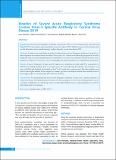Please use this identifier to cite or link to this item:
https://hdl.handle.net/20.500.14356/1181Full metadata record
| DC Field | Value | Language |
|---|---|---|
| dc.contributor.author | Shrestha, Lilee | - |
| dc.contributor.author | Karmacharya, Nabin | - |
| dc.contributor.author | Sharma, Saroj | - |
| dc.contributor.author | Basnet, Buddha Bahadur | - |
| dc.contributor.author | Jha, Runa | - |
| dc.date.accessioned | 2023-05-02T07:13:37Z | - |
| dc.date.available | 2023-05-02T07:13:37Z | - |
| dc.date.issued | 2021 | - |
| dc.identifier.citation | ShresthaL., KarmacharyaN., SharmaS., Bahadur BasnetB., & JhaR. (2022). Kinetics of Severe Acute Respiratory Syndrome Corona Virus-2 Specific Antibody in Corona Virus Diease 2019. Journal of Nepal Health Research Council, 19(04), 688-692. https://doi.org/10.33314/jnhrc.v19i04.3879 | en_US |
| dc.identifier.issn | Print ISSN: 1727-5482; Online ISSN: 1999-6217 | - |
| dc.identifier.uri | http://103.69.126.140:8080/handle/20.500.14356/1181 | - |
| dc.description | Original Article | en_US |
| dc.description.abstract | Abstract Background: Severe Acute Respiratory Syndrome Corona Virus 2019, a novel coronavirus first reported from China in 2019, is the causative agent of pandemic corona virus disease 2019. Antibody response and its dynamics may provide information about natural immunity conferred upon by corona virus disease 2019. Methods: A health-center-based follow up study of confirmed Severe Acute Respiratory Syndrome Corona Virus-2 infected patients was conducted from December 2020 to June 2021. Patients were followed up to period of 28 weeks during the study. An electrochemiluminescence immunoassay was used to test antibodies elicited by Severe Acute Respiratory Syndrome Corona Virus-2. Socio-demographic and clinical information was collected from each patient. Results: A total of 40 patients (18 males and 22 females) were enrolled in the study, with 90 % seropositivity of SARS-CoV-2 antibody. Antibody level was tracked up to 28 weeks following the infection, and persistence was observed till the end. Antibody level peaked on the 3rd to 4th month, after symptom onset. The male population was found to have higher antibody levels compared to females. Age-wise trend analysis showed lower antibody levels in the younger people (15-30 years) than those older (31-60 years). Conclusions: We demonstrated that Severe Acute Respiratory Syndrome Corona Virus-2 specific antibodies in corona virus disease 2019 patients persist for at least 28 weeks, peaking at 13 to 20 weeks. Statistically, there was no correlation of antibody levels with the age and sex of individuals. Further study on a larger population is needed for determining long-term immunity. Keywords: Antibody; kinetics; SARS- CoV-2. | en_US |
| dc.language.iso | en | en_US |
| dc.publisher | Nepal Health Research Council | en_US |
| dc.relation.ispartofseries | Oct-Dec, 2021;3879 | - |
| dc.subject | Antibody | en_US |
| dc.subject | kinetics | en_US |
| dc.subject | SARS- CoV-2 | en_US |
| dc.title | Kinetics of Severe Acute Respiratory Syndrome Corona Virus-2 Specific Antibody in Corona Virus Diease 2019 | en_US |
| dc.type | Journal Article | en_US |
| local.journal.category | Original Article | - |
| Appears in Collections: | Vol. 19 No. 04 (2021): Vol 19 No 4 Issue 53 Oct-Dec 2021 | |
Files in This Item:
| File | Description | Size | Format | |
|---|---|---|---|---|
| 3879-Manuscript-26773-1-10-20220313.pdf | Fulltext Download | 290.26 kB | Adobe PDF |  View/Open |
Items in DSpace are protected by copyright, with all rights reserved, unless otherwise indicated.
